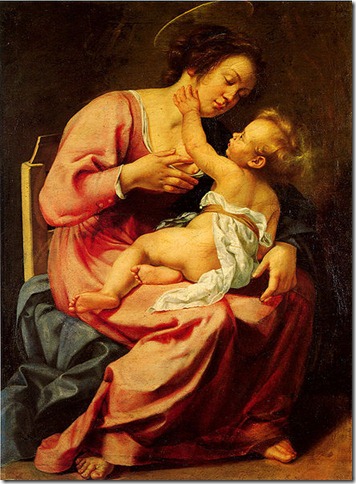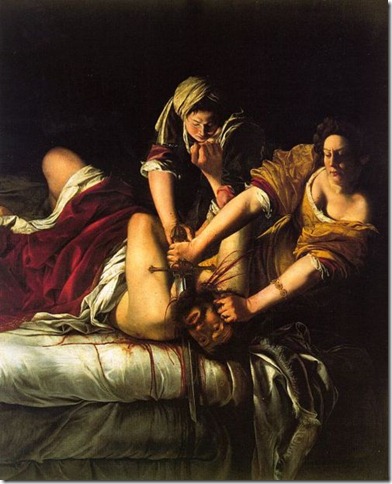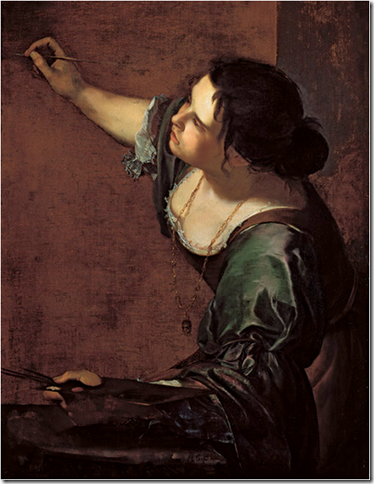Artemisia Gentileschi Posted by Serena on Mar 9, 2012 in Uncategorized
Yesterday, the 8th of March, was la Giornata Internazionale della Donna (International Women’s Day), and to celebrate the occasion I’m going to dedicate a post to the most famous Italian female artist of the Renaissance, Artemisia Gentileschi.
Artemisia was born in Rome on the 8th of July 1593, daughter of Orazio Gentileschi, an accomplished Florentine painter. Orazio encouraged all his children to become artists, but only Artemisia showed a natural talent from a very early age. Orazio, who was very proud of his daughter, tried to get her enrolled at the Accademia delle Arti, but she was rejected on the grounds that she was a woman, so her father decided to have her educated privately.
In 1991, I was lucky enough to see an exhibition of some of her works in Florence. At that time I didn’t know anything about Artemisia Gentileschi, as she was never mentioned in my art history books, and her ‘rediscovery’ had only just begun. By chance I happened to be in Florence and was going past Casa Buonarroti (Michelangelo’s house), one of my favourite places in Firenze. I noticed that there was an exhibition of work by several artists, I can’t remember who the others were, because I was so captivated by a painting of a Madonna with Child, which showed so much tenderness, and portrayed a sense of maternity rather than the usual religious iconography. Intrigued, I got closer to read the name of the painter, and that was the first time that I met her: Artemisia Gentileschi.
The Madonna and Child that caught my attention in 1991
As I wandered around the exhibition, another thing that made a big impression on me, apart from her obvious mastery, was the power and the violence of many of her art works, which goes far beyond the influence of Caravaggio, the artist who had the greatest influence on her work. At the age of 17 Artemisia suffered the trauma of being raped by Agostino Tassi, the painter engaged by her father to tutor her. She became his lover, believing that he would marry her, as he had promised. What she didn’t know was that he was already married, and had already been convicted for raping his sister-in-law and trying to kill his wife! When Orazio found out about the rape, he denounced Tassi. The trial lasted seven months, and Artemisia had to be submitted to unpleasant ‘intimate’ examinations to ascertain that she had been a virgin prior to the rape, and suffered painful thumbscrew torture to prove that she wasn’t lying (polygraphs didn’t exist in those days!). Tassi was declared guilty and condemned to either 5 years imprisonment or several years exile from Rome. The documents from the trial have survived, and we know that Tassi chose the latter, but was back in Rome after only a few months.
Judith, only a woman who had suffered like Artemisia could have depicted this traditional theme with such power and violence.
Artemisia went to live in Florence following an arranged marriage with the painter Pierantonio Stiattesi. Despite the trauma of the rape and ensuing trial she continued her career as a painter, and was held in great consideration, especially by Michelangelo Buonarroti the Younger, great-nephew of his famous namesake, and the Lord of Florence Granduca Cosimo II dei Medici, both of whom became her patrons. In 1616 Artemisia and her husband became members of the Accademia del Disegno (Academy of Design). She was the first woman ever to receive such an honour!
Artemisia had several children, but only one of them, a girl called Prudentia, survived. Despite her success as an artist, the family was continuously in financial trouble due to her husband’s gambling habit (men!). Following the death of Cosimo II Artemisia left Florence, moving first to Rome, then to the wealthy city of Genova, where she met the Flemish painter Van Dyke. She then returned to Rome, and finally settled in Napoli, the biggest and richest city of Southern Europe at that time. Whilst in Napoli she was also called to England to work for king Charles I, but she fled the country at the start of the civil war.
Self portrait circa 1630: this could almost be a work by one of the late 19th century impressionist artists such as Manet or Renoir.
Artemesia died in Napoli in 1652/3 and her name was soon forgotten. Many of her paintings were attributed to her father and other painters of the same period, and she remained all but unknown until the late 20th century, when, fortunately for us she was rediscovered. Although I didn’t know it at the time, the exhibition of her work which I saw in 1991 in Florence was her first.
Here is a documentary in Italian about Artemisia in two parts: Artemisia Part 1. Artemisia Part 2.

Build vocabulary, practice pronunciation, and more with Transparent Language Online. Available anytime, anywhere, on any device.







Comments:
Linda:
Beautiful! Love it! 🙂
Allan Mahnke:
Tante grazie! C’era un film qui negli Stati Uniti pochi anni fa. Era interessante ma … non tanto! Questo blog è meglio!!
Allan & Kathryn
Susan:
Che bella La Artemisia. Sono ringrazia per questa informazione.
Serena:
@Susan E io sono molto grata per il tuo commento 🙂
Serena
Marisa:
Wow. I haven’t heard this name since the late 80’s when my friend, Heather Favell, requested my dad translate one of Artemisia’s letters – although the name really stuck in my mind! Heather was studying Fine Arts at the U of Manitoba. She passed away last year so this story is doubly sorrowful for me.
John Kewley:
I thought that the people had spoken about receiving the ‘Italian Blog’ in this form.
6 – 12 months ago this form of sending only a header, was rejected by a number of followers including myself.
I want to receive the whole content of the post in my email to read, to add comments and forward on to my own students
Serena:
@John Kewley Salve John, I don’t actually have anything to do with that side of things, I’m just a humble blogger. I’ve passed your comment on to my manager.
Saluti da Serena
P.S. Un po’ di buona educazione non fa mai male!
Transparent Language:
Greetings,
Just wanted to address the switch back to a preview only of the blog article in RSS feed emails. We understand that it can be more convenient for readers to get the entire post in an email, and that’s why we gave it a try. The problem that arose was that, instead of commenting on the blog article itself, readers were hitting reply to the email. The comments we were getting were useful, insightful information, and not only was the blogger not receiving these comments – other readers could not benefit from them either. Many such cases included questions that would have been valuable to discuss as part of the article, for all readers (who likely had similar questions) to see.
For these reasons, we went back to a preview format of the RSS email. I just wanted you to know that we don’t make these decisions arbitrarily, and there was a very important reason for it.
Regards,
– Lorien, Social Media Manager
Transparent Language, Inc.
communityfocus@transparent.com
Claudia:
Artemisia’s story is so inspiring. Thanks for sharing it and for helping people discover this great artist!